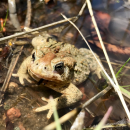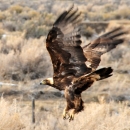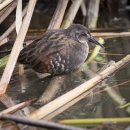About Us
The wetland complexes of Bamforth National Wildlife Refuge provide important water resources that support resting, nesting and foraging areas for migratory birds in the semiarid environment of the Laramie Plains basin. The three Laramie Plains refuges, Bamforth, Hutton Lake and Mortenson Lake are designated as Important Bird Areas by Wyoming Audubon.
The two main habitats on Bamforth National Wildlife Refuge are greasewood/grassland upland and alkali flats. There are also small ponds and Bamforth Lake that provide some marsh and wetland areas. A variety of migratory birds use the refuge wetlands, including American white pelicans, California gulls, double-crested cormorants, black-crowned night herons, American avocets, and snowy egrets. Many songbirds spend time in the greasewood/grassland areas, including western meadowlarks, vesper sparrows, horned larks, brown-headed cowbirds, and Brewer's sparrows.
Our Mission
The mission of the National Wildlife Refuge System is to administer a national network of lands and waters for the conservation, management and, where appropriate, restoration of the fish, wildlife and plant resources and their habitats within the United States for the benefit of present and future generations of Americans.
Our History
Bamforth National Wildlife Refuge is located within 6 miles of Laramie, Wyoming. Laramie is positioned in a high plains basin ecosystem known as the Laramie Basin. The shallow depressions of the basin, within the relatively flat topography of the region, support wetland complexes that are unique to the area. These wetland complexes provide resting, nesting, and breeding areas for migratory birds in the semiarid environment. In the early 1930s, J. Clark Salyer III was charged with identifying areas to protect as national wildlife refuges for migratory birds. He surveyed the area around Laramie and selected two locations as national wildlife refuges for migratory birds. Bamforth National Wildlife Refuge and Hutton Lake National Wildlife Refuge were established by executive orders in 1932 within one day of each other.
Bamforth National Wildlife Refuge was established on January 29, 1932, by Executive Order 9321. Consisting of 1,166 acres, the refuge is located approximately 6 miles northwest of Laramie. The refuge was established with 201 acres withdrawn from the public domain in 1932, and 965 acres purchased with Migratory Bird Conservation Act (Migratory Bird) funds in 1933. Due to a number of factors, Bamforth National Wildlife Refuge has remained within the Refuge System but has not been actively managed. The refuge comprises three parts arranged roughly in an L-shaped pattern, with the segments one-half mile apart. Lands adjacent to and in between refuge parcels are owned by the state of Wyoming and private parties. The refuge is located in a closed basin hydrologic system that contains Bamforth Lake, but most of the lake falls outside the refuge boundary. The fragmented parcels, closed basin hydrology, and minimal water rights have contributed to the lack of active management of this refuge.
Other Facilities in this Complex
Bamforth National Wildlife Refuge is managed as part of the Central Sage Steppe Conservation Complex. A Conservation Complex is a group of two or more refuges, wildlife management areas, wetland management districts, or conservation areas that are primarily managed from a central office location. Refuges are grouped into a complex because they occur in a similar region, such as a watershed or specific habitat type, and have a related purpose and management needs. Typically, a project leader oversees the management of the refuges within the complex and refuge managers are responsible for operations at specific refuges. Support staff: administrative, law enforcement, refuge manager, biological, fire, visitor services, and maintenance, are centrally located and help with all refuges within the complex.
Other refuges in the Central Sage Steppe Conservation Complex include: Arapaho National Wildlife Refuge (Walden, Colorado); Pathfinder National Wildlife Refuge (Alcova, Wyoming); Bamforth National Wildlife Refuge, Mortenson Lake National Wildlife Refuge, and the Wyoming Toad Conservation Area (Laramie, Wyoming); as well as Seedskadee National Wildlife Refuge (Green River, Wyoming), Cokeville Meadows National Wildlife Refuge (Cokeville, Wyoming), and Wyoming's portion of the Bear River Watershed Conservation Area. Administrative headquarters for Arapaho, Pathfinder, and the Laramie Plains refuges is located at Arapaho National Wildlife Refuge, in Walden, CO phone number 970-732-8202, while administrative headquarters for the southwestern Wyoming refuges is located at Seedskadee National Wildlife Refuge, 37 miles north of Green River on Hwy 372 - 246 Seedskadee Road, PO Box 700, Green River, WY 82935; phone number 307-875-2187.






